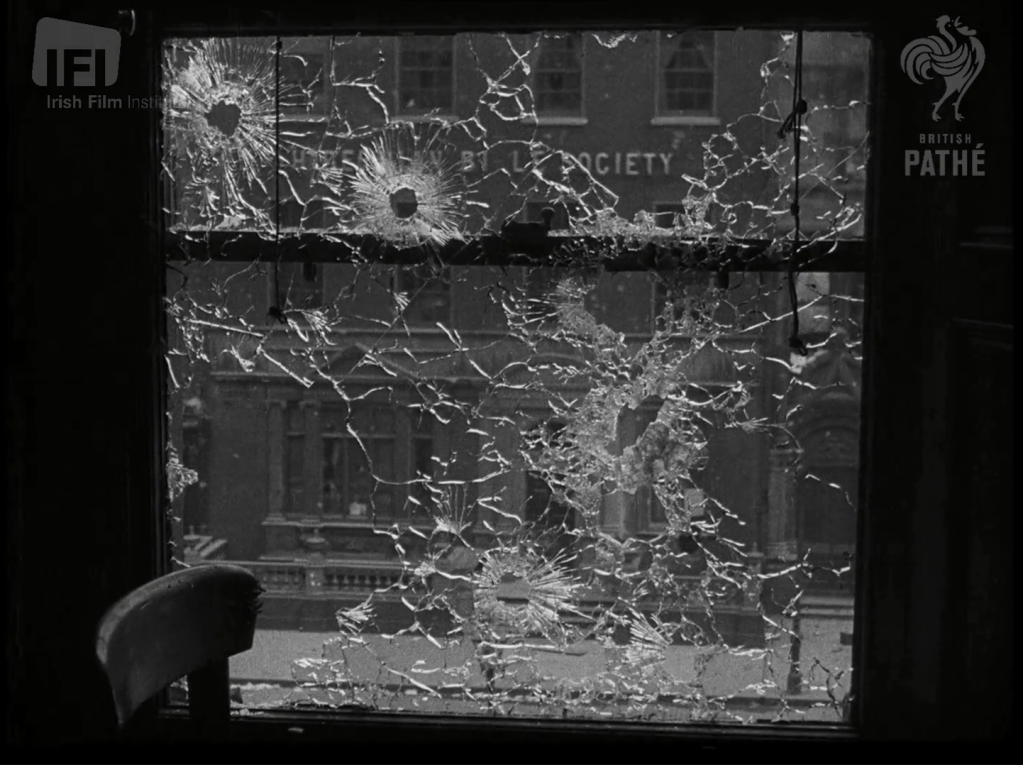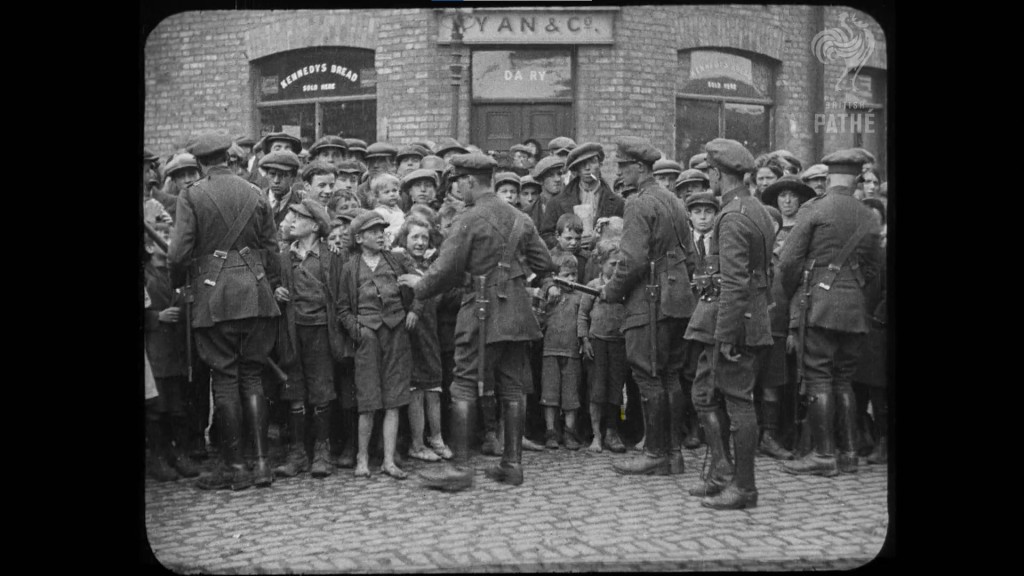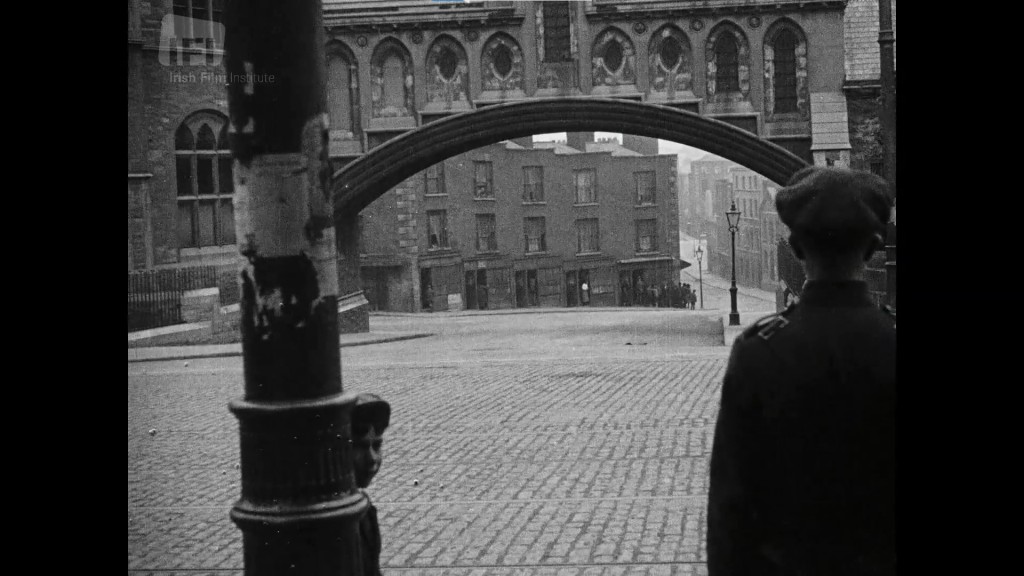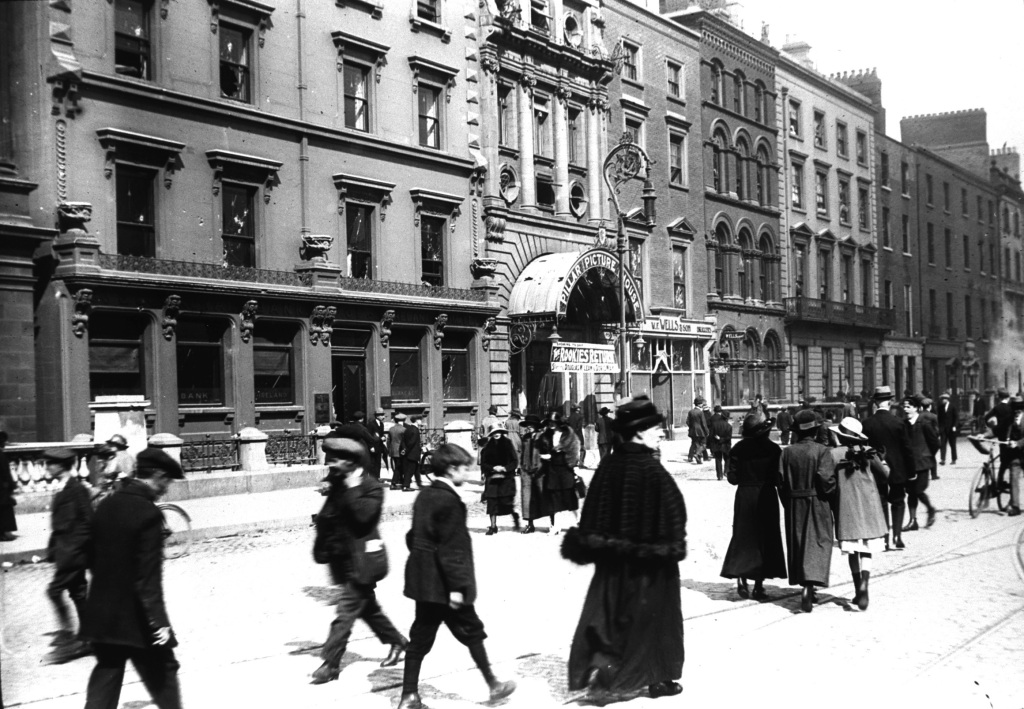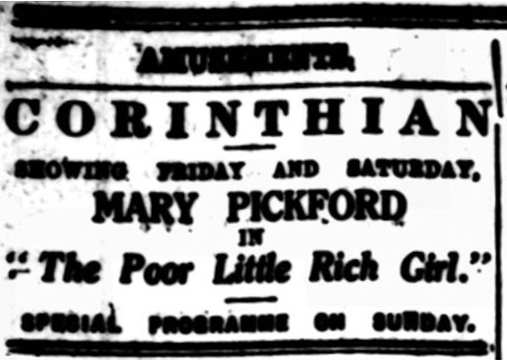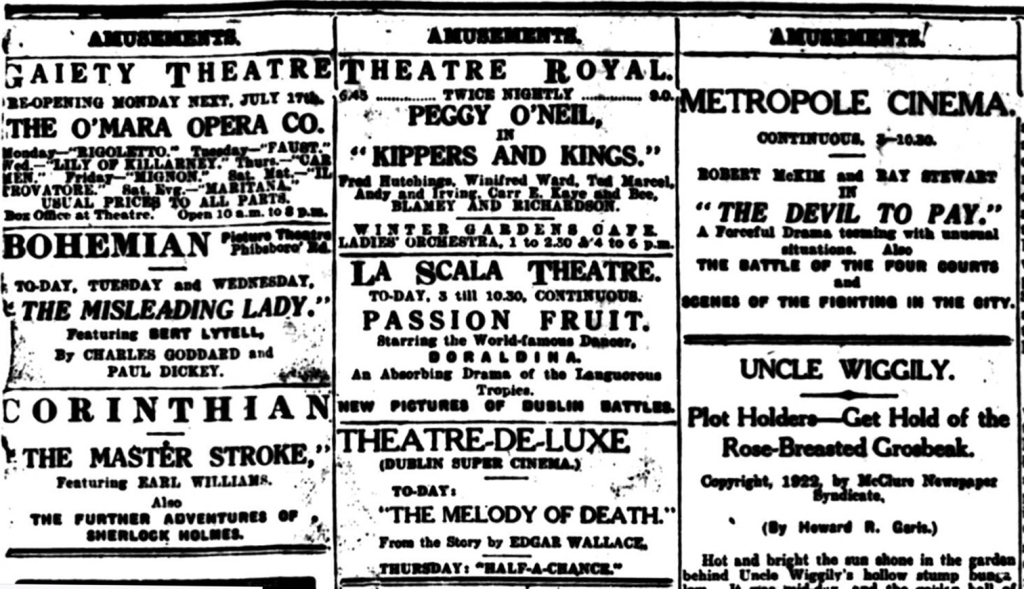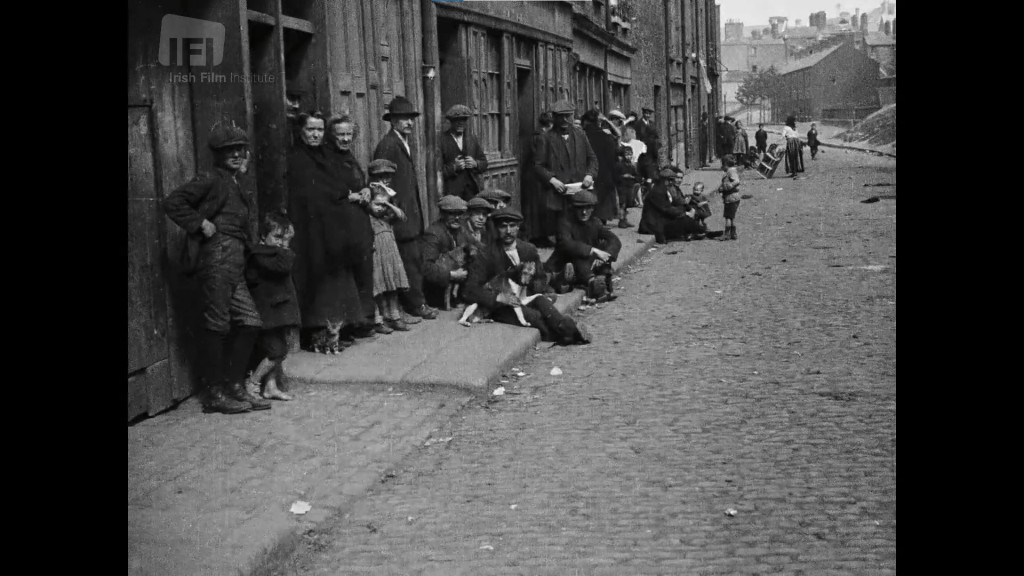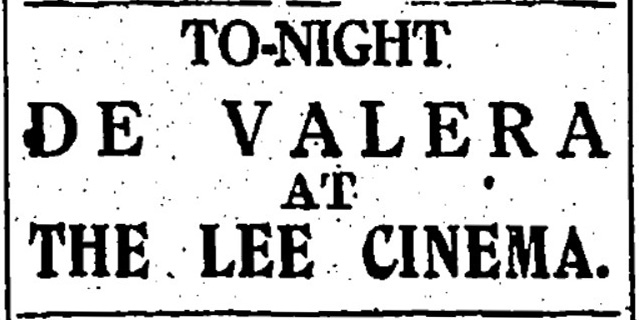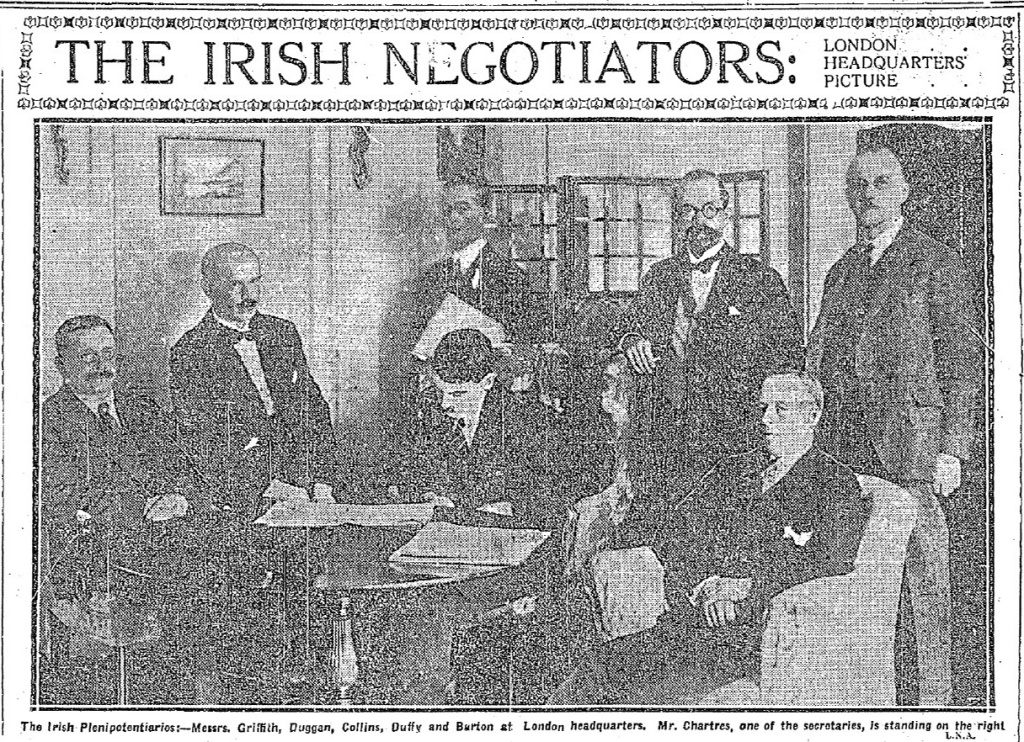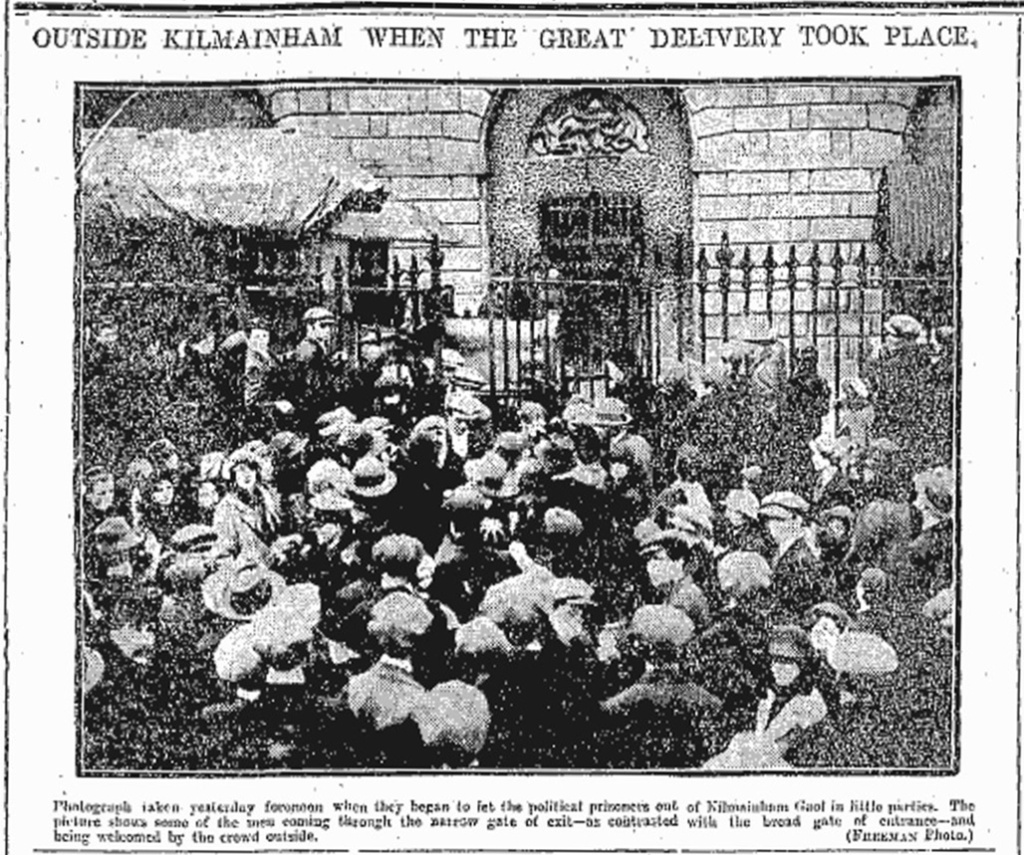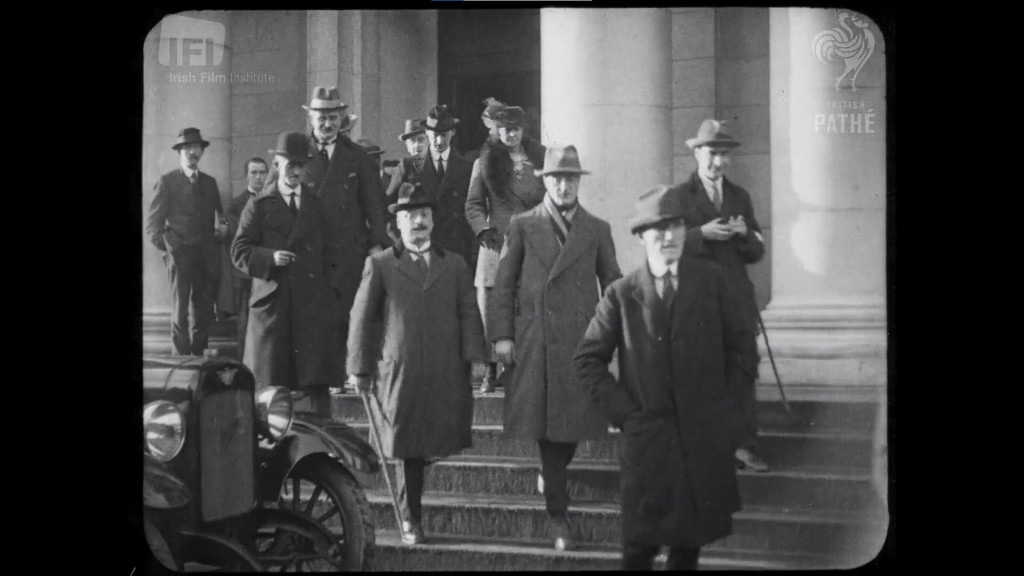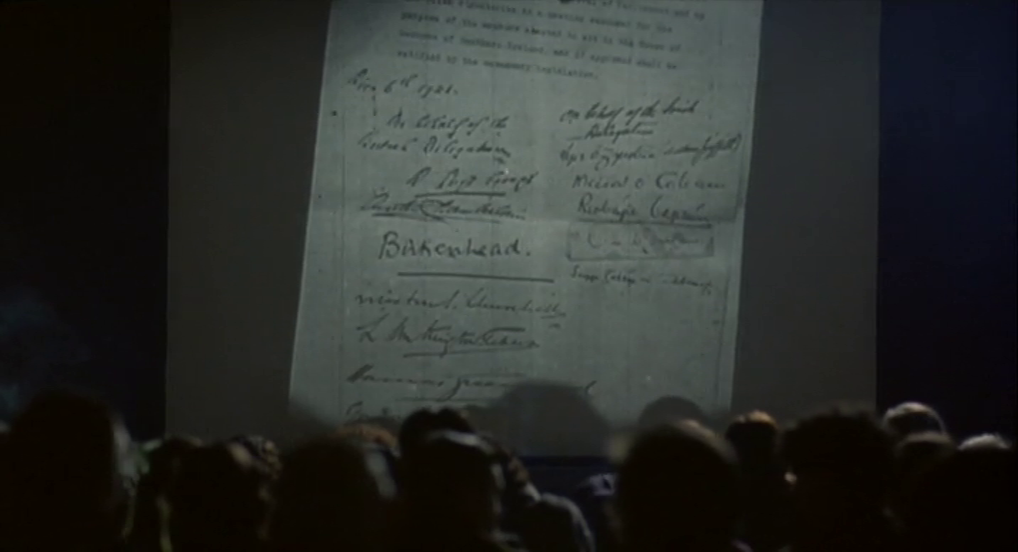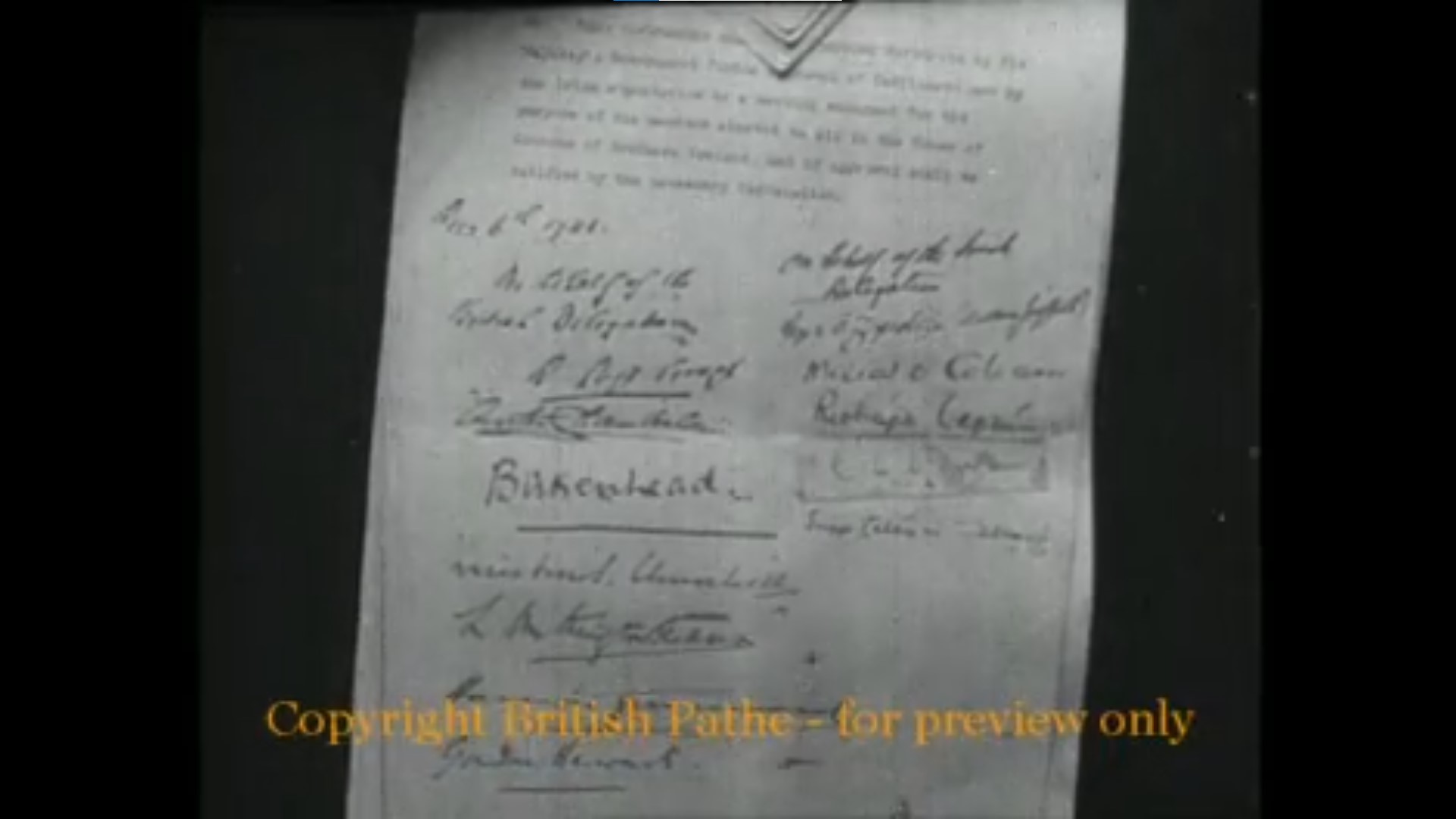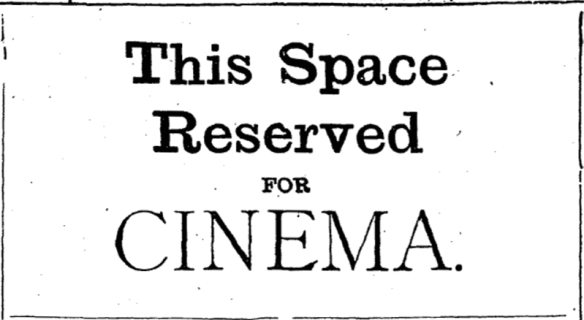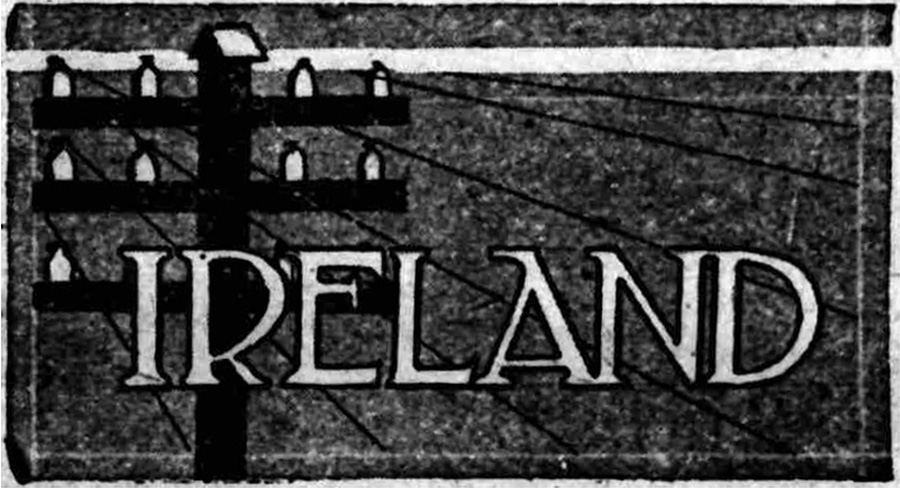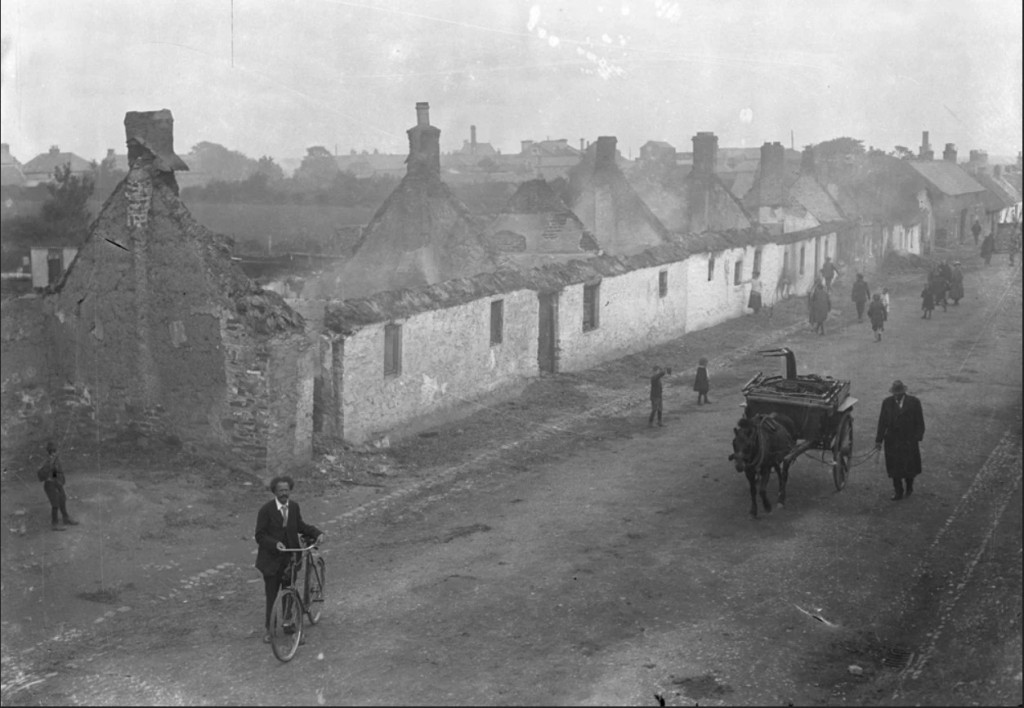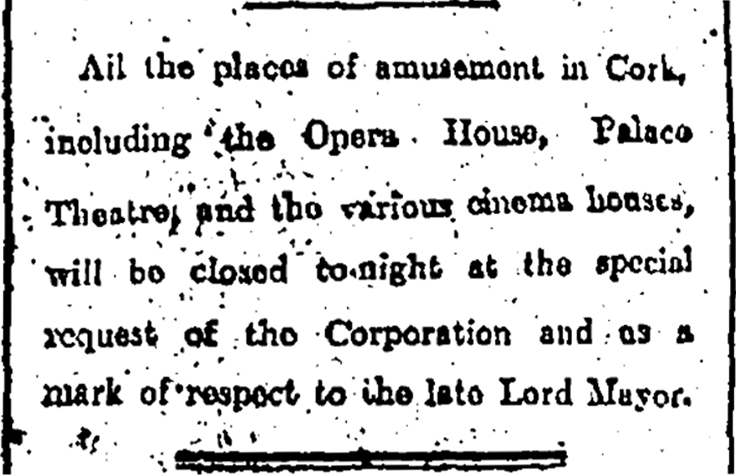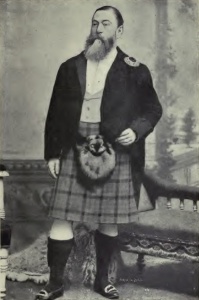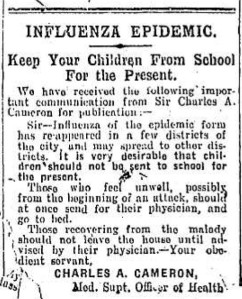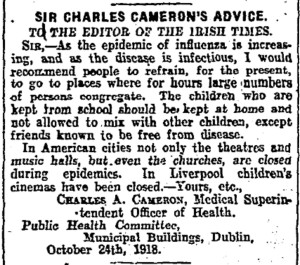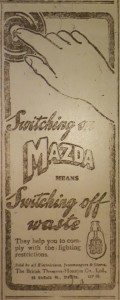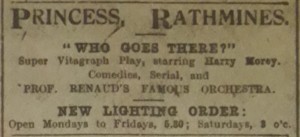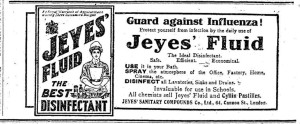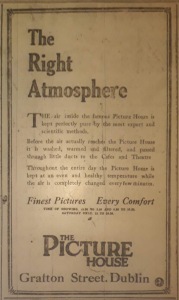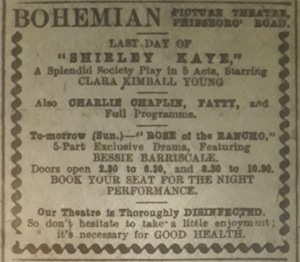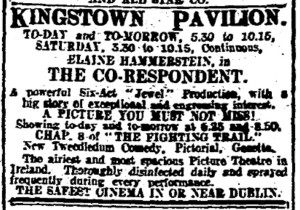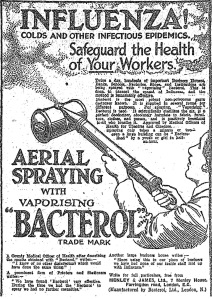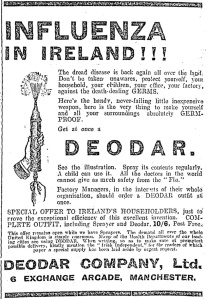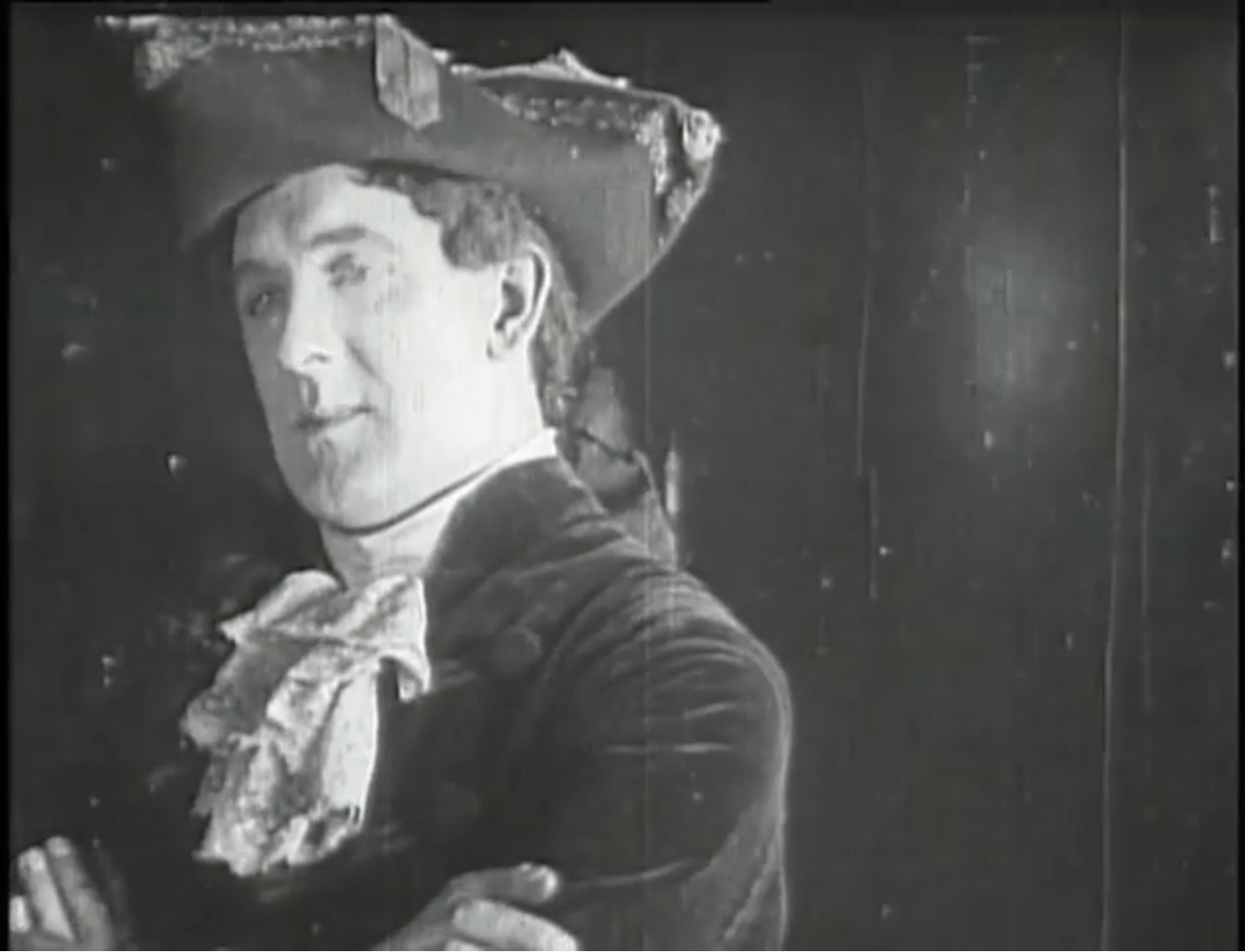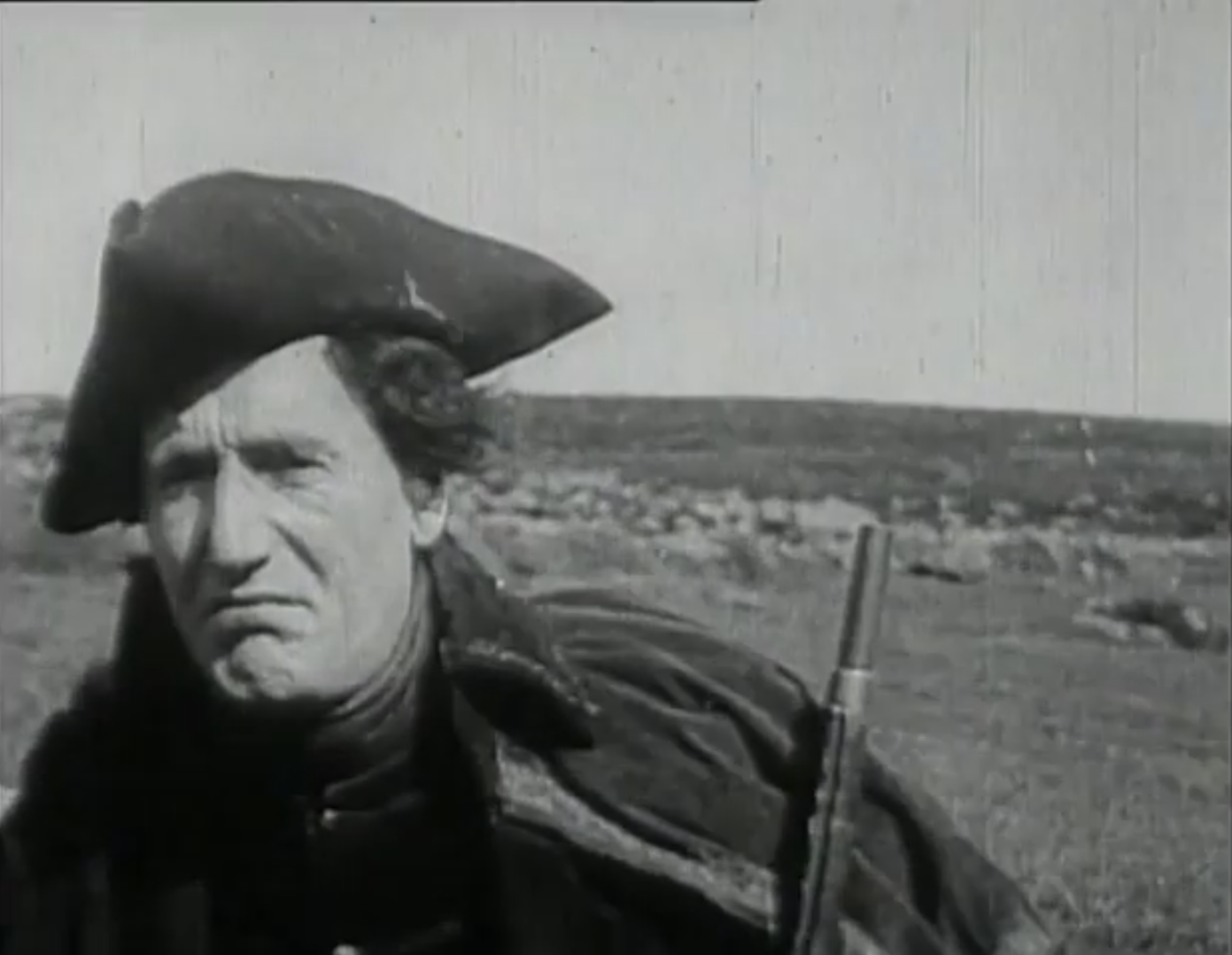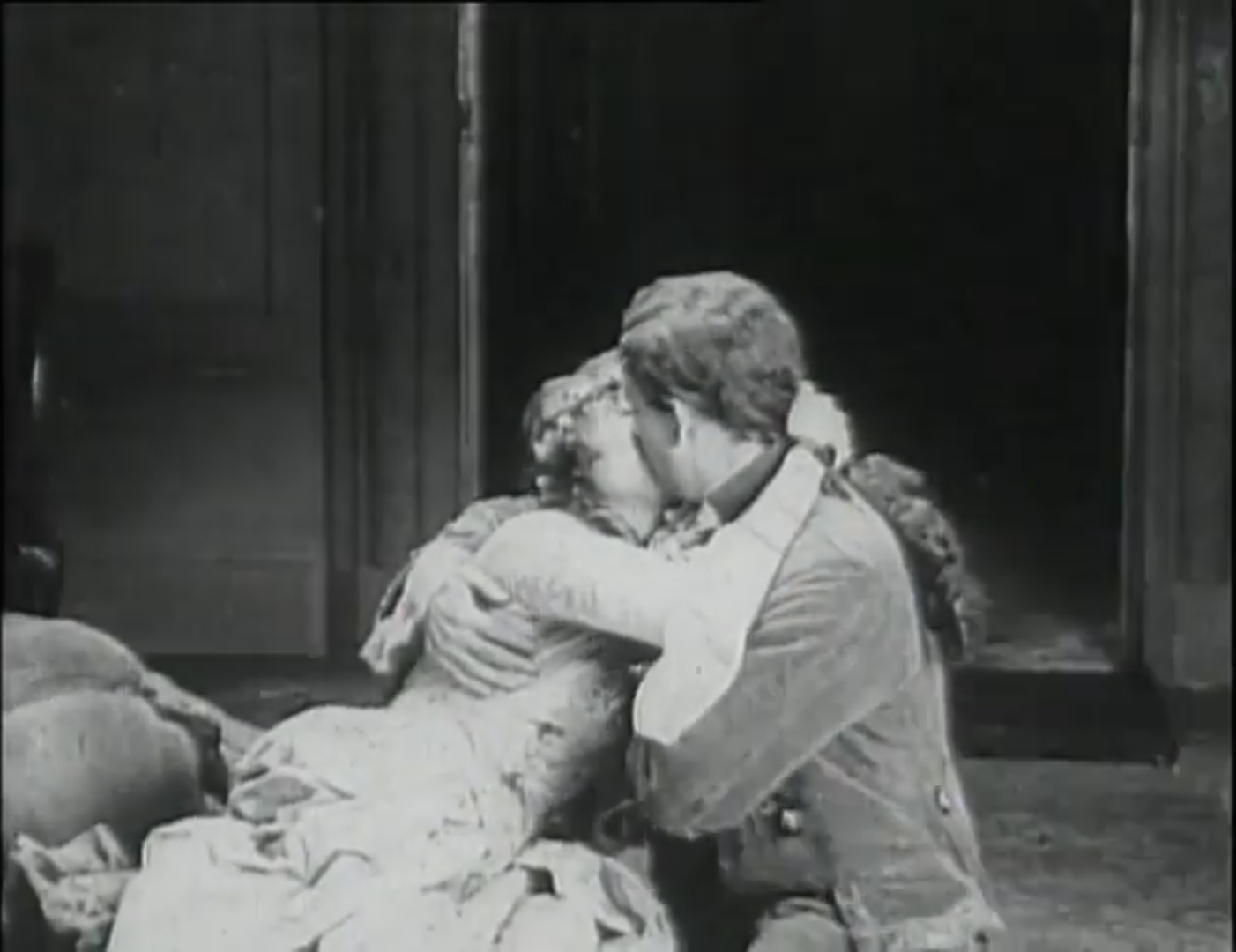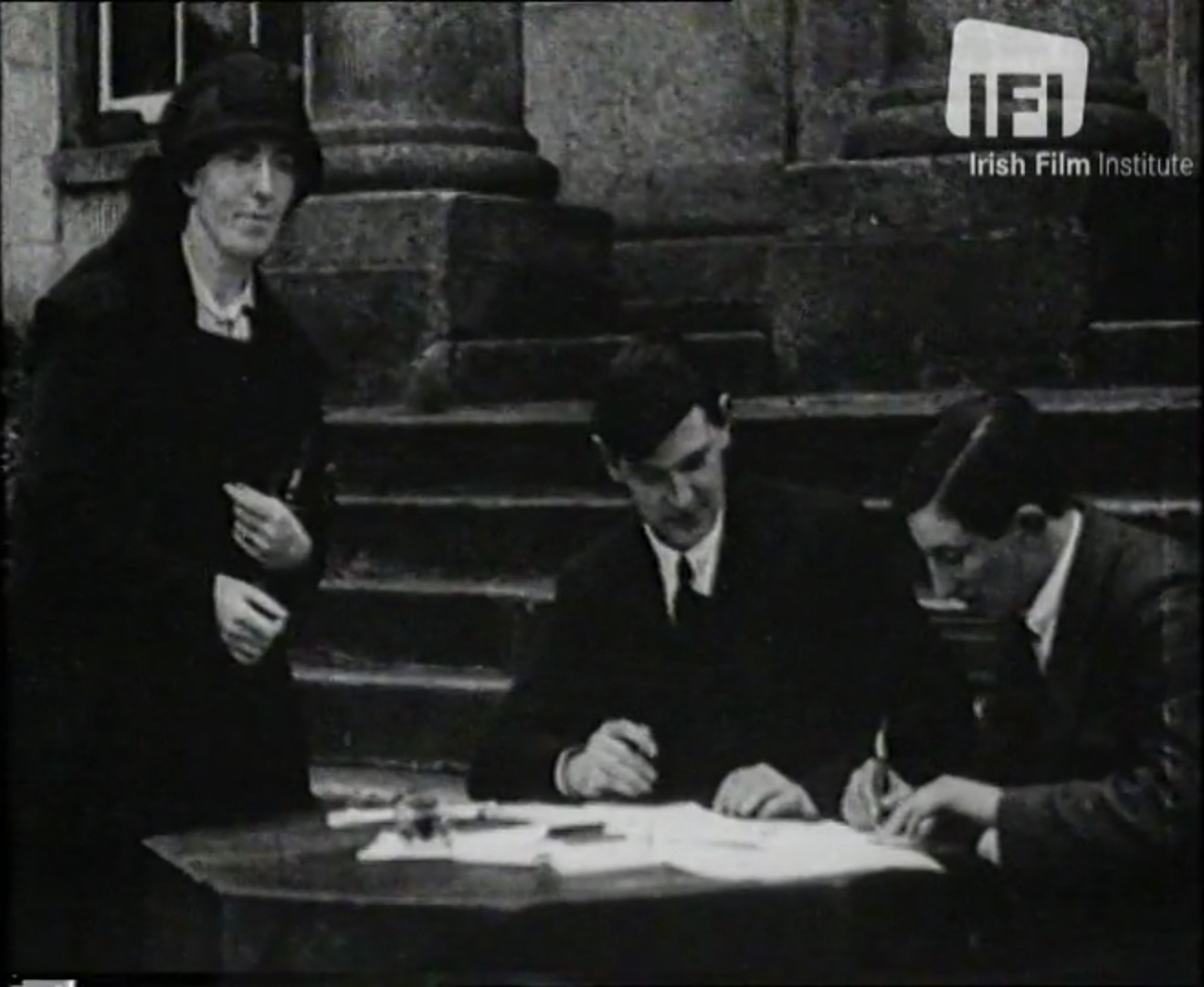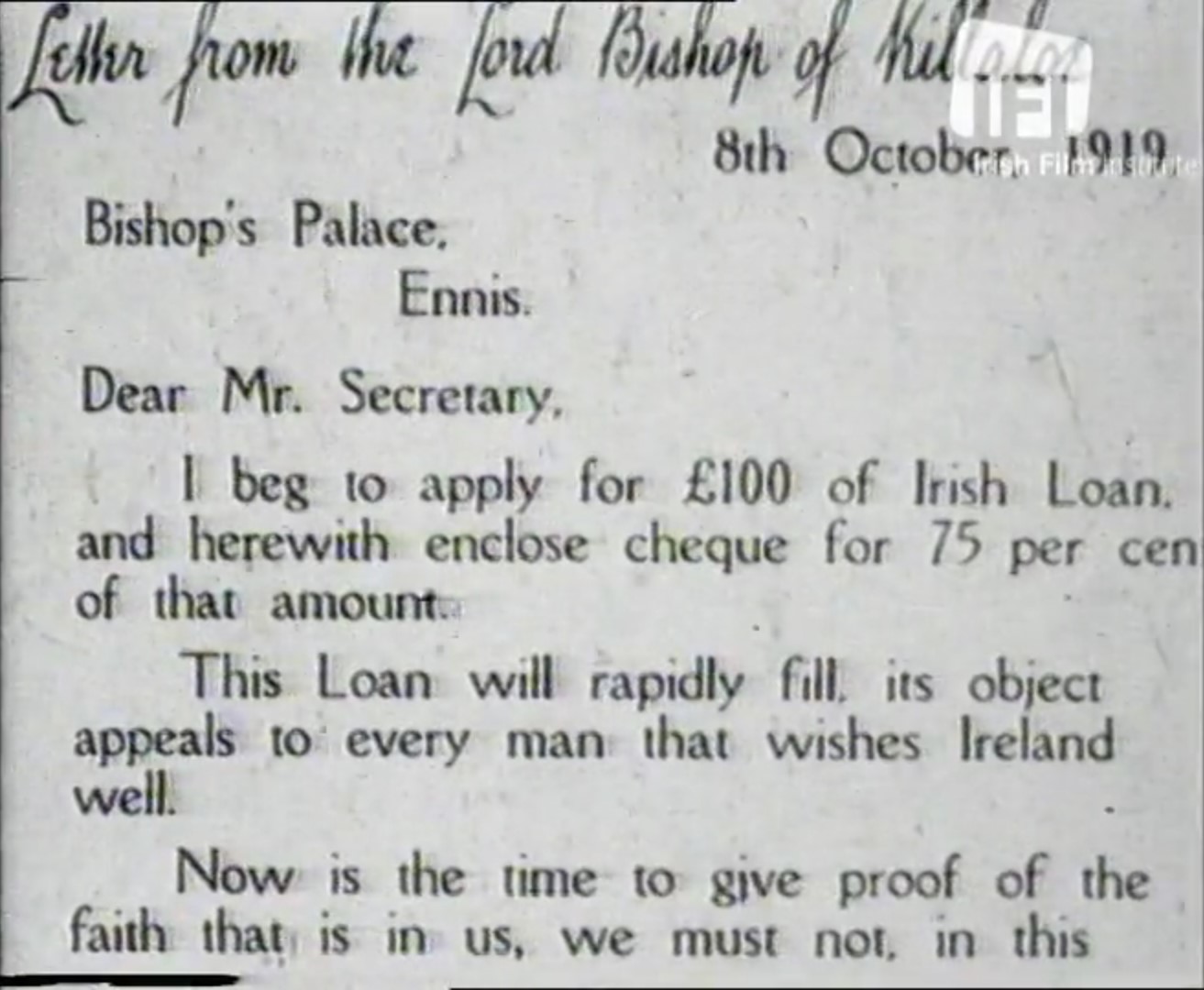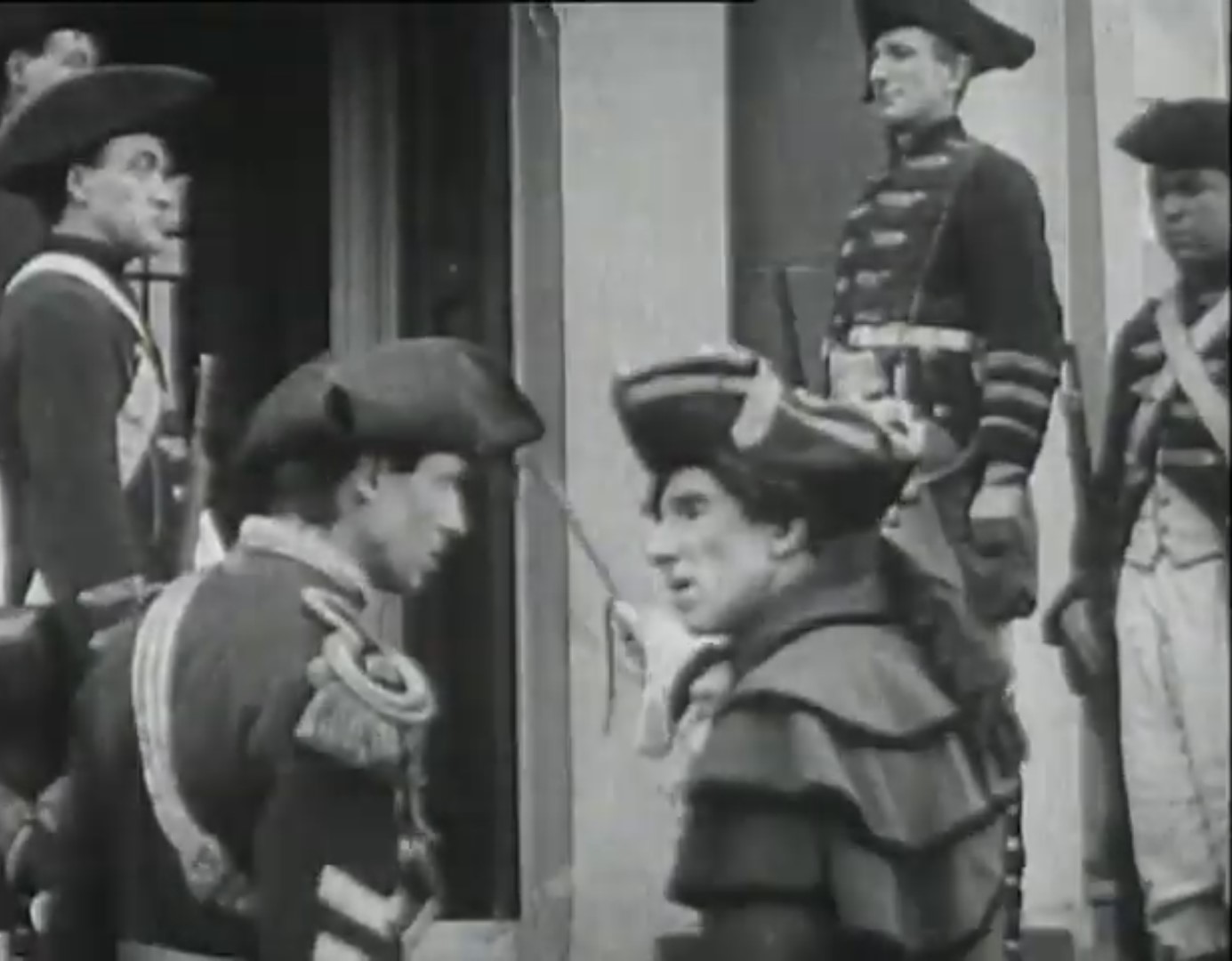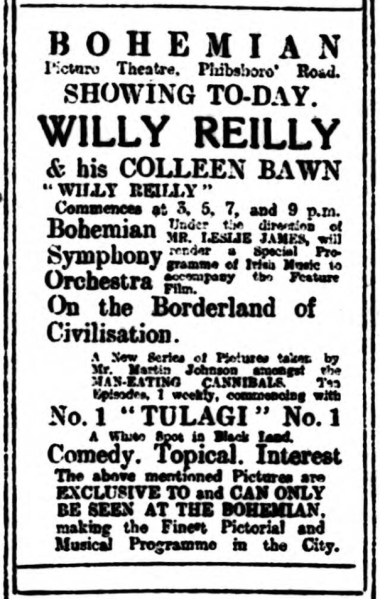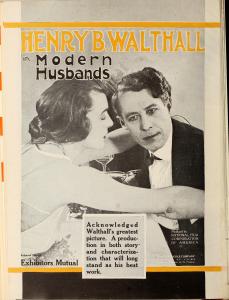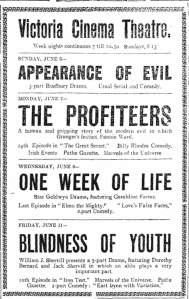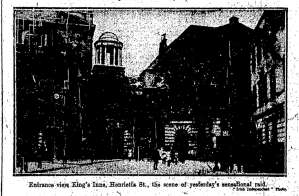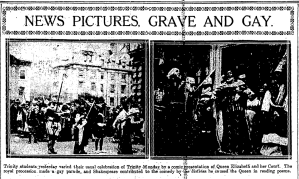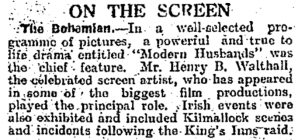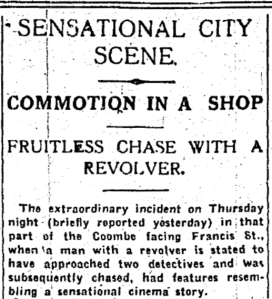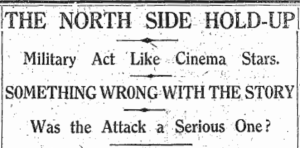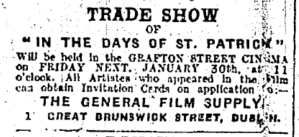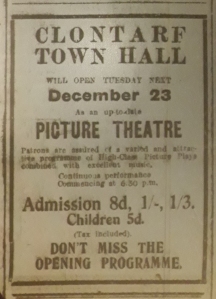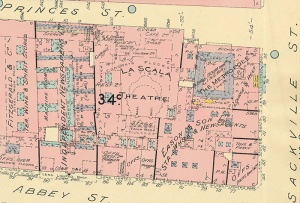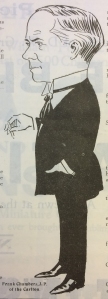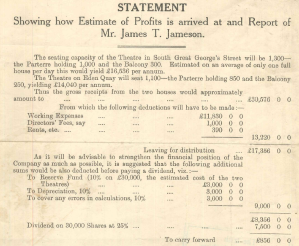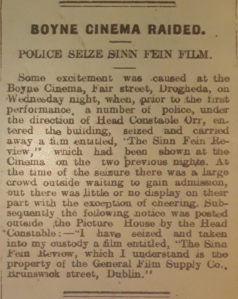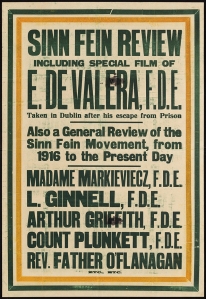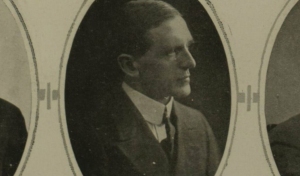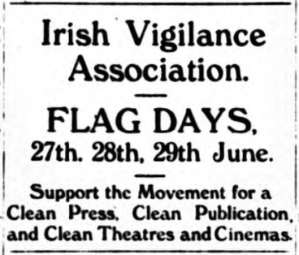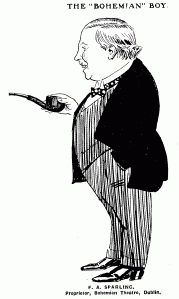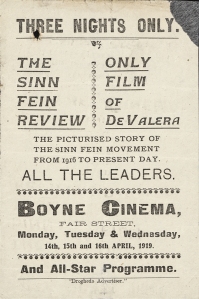I planned to research and write this blog in mid-March 2020 because it is about Irish cinema in March 1920 and particularly the films released for that year’s St Patrick’s Day (17 March). But things didn’t turn out as planned. I do a significant part of the research for these blogs on newspapers and archive materials at the National Library of Ireland (NLI), the Mothership. The COVID crisis closed the NLI to researchers in the crucial week from 12 March, and I have deferred this blog a long time in the hopes of a reopening of the library and access to my own office and books, but I am now finally finishing it under quarantine conditions. I have always used online sources alongside printed ones in these blogs, but in this case, they are almost the only sources. Expect some revision later, but in the meantime, I especially welcome comments on this blog to correct the errors and fill in some of the gaps.

Ira Allen as St Patrick in Aimsir Padraig/In the Days of St Patrick. Standard 17 Mar. 1961: 1.
St Patrick’s Day and the week in which it fell were often the occasion for Irish cinemas to show films with Irish content of some kind, but St Patrick’s week 1920 uniquely saw the premieres of two new indigenously produced feature films, Aimsir Padraig/In the Days of St Patrick (Ireland: General Film Supply, 1920) and Rosaleen Dhu (Ireland: Celtic, 1920)), albeit that there is some doubt about the latter premiere. Neither of these films was made by the Film Company of Ireland (FCOI), which had dominated the production of indigenous fiction films since its founding in 1916 and whose awaited production of Willy Reilly and His Colleen Bawn was being held for a symbolically significant late April release coinciding with the fourth anniversary of the 1916 Rising. Spring 1920 was indeed a rich one for new Irish features.
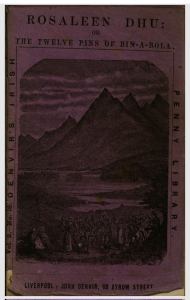
The cover of John Denvir’s play Rosaleen Dhu, which was published in his pamphlet series Denvir’s Irish Penny Library: Google Books.
Of the St Patrick’s Day releases, Aimsir Padraig (I will use this shortened form of the title from now on) is today by far the better known, largely because it still survives and has been shown on such occasions as the 2017 St Patrick’s Festival at Dublin’s Irish Film Institute with live accompaniment. Directed and starring Bray, Co. Wicklow barber William J. Power based on the eponymous 1874 play by John Denvir, Rosaleen Dhu is the more obscure film because it is believed lost and as a result, nobody has seen it in nearly a century, but it has received attention from several historians and critics of Irish cinema, including most recently Debbie Ging, who offers insights into the film’s gender dynamics based on her analysis of the synopsis published in Kevin Rockett’s Irish Filmography (Rockett 9 and online). Paraphrasing Rockett’s pithy synopsis, Ging observes that the film tells the story of how
“a young Fenian emigrates after being evicted from his home during the Land Wars. He joins the French Foreign Legion and marries a local woman in Algeria, only to discover on his return to Ireland that his bride is the kidnapped heiress of an Irish estate. His masculine virility is thus recouped through his own existential actions, while the matter of wealth and property ownership is taken care of by forces beyond his control. (Ging 44.)
So although Rosaleen Dhu is a relatively obscure lost Irish film, it is still being used in some very interesting contemporary work. Something also might be said about the film’s own Orientalist indulgence in colonial adventuring, and particularly the representation of Algeria, a feature unique in Irish film and one that caught the attention of the reviewer in the December 1919 issue of Ireland’s first film magazine Irish Limelight. “The plot centr[es] chiefly around the love affair of a most captivating young Irishman,” s/he reveals.
As a result of the machinations of the villain of the piece, the hero has to take flight from Ireland, and the final phases of the picture depicts most realistic and highly exciting incidents in Algiers, where exciting encounters, captures and rescues are the order of the day.
Our hero finds his bride, and finally all return to a happier Ireland, the villain having met with his just deserts. (“Celtic Film Company’s ‘Rosaleen Dhu.””)
It is striking that the Limelight writer doesn’t describe the hero – Stephen Burke, as in Denvir’s play – as a Fenian, a member of the secret Irish republican organization responsible for notable revolutionary actions in the 1850s and 1860s. Indeed, s/he very carefully frames the political context in which the action takes place by observing that it is a “delightful portrait of Irish life in the middle of the last century, [portraying] in the most faithful manner the exciting phases of the lives of the people in the early days of the Land War.” That setting would have been anachronistic for a faithful adaptation of Denvir’s play, which had been published five years before the Land War began in 1879. Nevertheless, having located the film in the context of a key Irish political struggle, the reviewer disavows any substantial ideological content, commenting that “happily anything that could be objectionable in the way of political controversy or class hatred is completely absent from the picture.” The frequency with which statements like this formed part of the contemporary commentary on the film suggests that they were part of the film itself, perhaps as introductory intertitles, and/or travelled with it as part of the material the producers provided for the press. As has been noted here a number of times, producers of Irish films denied that they were politically partisan in order to avoid censorship. This seeming neutrality was often a conservative political accommodationism, as it had been in the Irish play, the genre of 19th-century melodrama to which Denvir’s play belonged and of which the work of Dion Boucicault is the best remembered. And as in the case of the Irish play, neutrality in both colonial and class politics was good for business in not alienating any sector of the potential audience. Nevertheless, as with Boucicault and other popular Irish dramatists, a seemingly conservatism overall could conceal but not wholly contain the presentation of radical ideas in the course of the play. In any event, stressing the “all Irishness” of the production may be as far as an Irish film could have gone to make a political point at a time when the Irish War of Independence was becoming increasingly violent. As the ad for the Sligo run put it: “All Irish Artists. All Irish Scenes. From an Irish Story. By an Irish Author.”
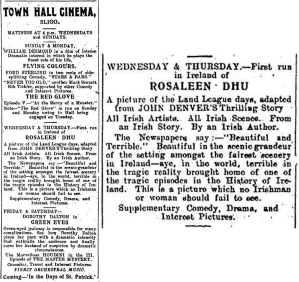
Ad for the premiere of Rosaleen Dhu at Sligo’s Town Hall Cinema on 17-18 March 1920. Sligo Champion 13 Mar. 1920: 4.
Indeed, this Sligo run at the Town Hall Cinema on 17-18 March 1920, seems to have been the public premiere. Although Rockett lists the premiere as 16 December 1919, this is likely the trade show at Dublin’s Carlton Cinema that the Limelight advertised for that day. Although the Sligo Town Hall management was not above making exaggerated claims about the exclusiveness of the films it showed, searches in the currently digitized newspapers yield no mentions of screenings in late 1919 and early 1920 before those in Sligo, the publicity for which claimed that it was the first run in Ireland. “The management of the Town Hall Cinema is to be congratulated on having secured for Sligo people the first exhibition in Ireland of the famous Irish film, ‘Rosaleen Dhu,’” a preview in the Sligo Champion declared. “It is interesting to note that the picture has been produced wholly in Ireland. The settings are principally laid amongst the beautiful mountains of Co. Wicklow, and the introduction of the Algerian desert sand scene provides an atmosphere of reality which makes the picture doubly interesting” (“‘Rosaleen Dhu’”). The lack of political controversy was also stressed in Sligo: “It is a picture of intensely human interest, free from any tinge of politics, and can be seen by all creeds and classes of Irish people with an interest which brings home to them real Irish life in every scene.”
The film remained faithful to the play, but as the mentions of Wicklow indicate, it was shot on the east coast and not on the West of Ireland locations mentioned in Denvir script. While the film’s Irish scenes still supposedly took place in Connemara – the play’s subtitle The Twelve Pins of Bin-a-Bola incorporates the English and Irish names of a Connemara mountain range – director and star William Power shot in scenic Wicklow locations that were within easy reach for him and his Bray-based collaborators. The most extensive synopsis of the film, published in the Nationalist and Leinster Times before a run at Carlow’s Cinema Palace in 1922, shows that Power altered the play only so that he could produce a coherent silent film from the dialogue-heavy play. The largest alteration, therefore, was the inclusion of a prologue showing how the villainous steward Mark Luttrell’s conspires with his henchman Ned Malone to murder landlord Sir Hugh Dillon, his wife and their daughter, Rosaleen Dhu, while on a voyage to Spain, but how Malone in bad conscience spares Rosaleen Dhu life and instead sells her to “Ben Mouza, an Arab Chief” (“Rosaleen Dhu”).
Most of what is known of Power’s filmmaking activities comes not from contemporary sources directly but from Padraig O’Fearail’s 1977 Irish Times article “When Films Were Made in Bray.” Some 57 years after the events, O’Fearail not only used 1919-20 local newspaper articles but also interviewed people who had been involved in the making of Rosaleen Dhu and the other films produced by Power’s Celtic Cinema Company. The accounts of Power’s young assistant Bob Tobin and his female lead Kitty Hart (formerly Scarff) allow O’Fearail to offer a vivid account of local filmmaking in Ireland as the 1910s became the 1920s.

Mac’s, or the Picture House, Quinsboro Road, Bray, Co. Wicklow was located in the town’s former Turkish baths. Mac himself – J.E. McDermott – is probably the man leaning against the façade. Irish Limelight August 1917: 16.
From his article we learn that Power was a barber working from a shop at 1 Novara Avenue in Bray, which became the production office during shooting, with barrels for processing film in its yard; that Tobin’s blind brother Matthew operated the camera at times when all that this required was for him to turn the handle moving the film through the camera at a steady pace; that Power’s first film was the one-reel comedy called Willy Scouts While Jessie Pouts; that Power collected Kitty, an experienced amateur actor, from her tobacconist’s job when the weather was good for filming; and that he died on 20 June 1920 from injuries sustained while shooting a racing scene at Leopardstown race course for An Irish Vendetta, his follow up to Rosaleen Dhu. O’Fearail is less interested in the exhibition of the film, merely quoting Bray native Christy Brien’s claim that it was shown at Mac’s in Bray at an unspecified date and speculating that it was screened at other cinemas in Wicklow and probably beyond.

Rosaleen Dhu’s Dublin premiere at the Rotunda; Evening Herald 1 May 1920: 5.
By the time of the Sligo premiere, the Irish film community would have known of the film from articles on it in the Limelight and Bioscope, but there were few advertised runs of the film in 1920. Among those few screenings were its Dublin and Belfast premieres. Tom Hughes shows that the Belfast premiere happened sometime in March or April as part of a series of Irish films at St Mary’s Hall, a church venue that had decided to run as a full-time cinema and booked the three new Irish films to launch the enterprise (Hughes 281-82). The Dublin premiere was later, at the Rotunda, where “packed houses witnessed the screening of the Irish-made film ‘Rosaleen Dhu’ when Mr. Kay reopened the Ro[tu]nda last week” (“Irish Notes” 13 May). Kay clearly saw that run as successful because he brought the film back for a three-day engagement beginning on 8 July 1920.
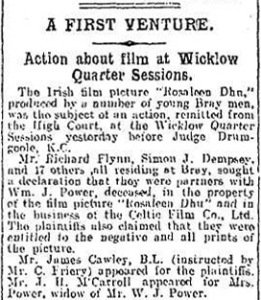
Extract from a Dublin high court case to establish the ownership of Rosaleen Dhu. Evening Herald 4 Jun 1921: 3.
Few other screenings are registered in 1920, which may not be surprising given Power’s unexpected death in June. This was not the end of the film’s screening life, however. The Celtic Film Company under whose name Power produced his films was a partnership involving 15 other Bray residents, and in April-June 1921, they sought to have their rights to all copies of the film and business to do with it asserted in the face of Ellen Power’s insistence that her husband owned the rights. She lost the case, and the company put the film back into circulation. It was subsequently shown – among other places, no doubt – in Skibbereen in August 1921, Cork city in October 1921 and Carlow in April 1922.

Ads for Dublin cinemas showing Aimsir Padraig/In the Days of St Patrick in Dublin Evening Mail 15 Mar. 1920: 2.
Aimsir Padraig/In the Days of St Patrick suffered none of Rosaleen Dhu’s struggles to make news in 1920. “Quite the most important feature of this year’s celebration of the National Holiday in the Irish Capital,” the Sligo Champion commented,
was the presentation, in picturized form, of the Life of St. Patrick – the National Apostle. This may seem rather an extravagant assertion, but when one considers the tremendous power for good or for evil possessed by the cinematograph, and when one sees the power being moulded by native talent in the service of purposes of national religious advancement, the success of the experiment becomes a matter of very grave concern. In the leading Dublin cinemas we are delighted to say the wonder film, ‘In the Days of St. Patrick,’ has proved a tremendous success.” (“The Life of St. Patrick.”)
In Dublin itself, the Freeman’s Journal noted in a roundup of events for St Patrick’s Day that “there will be special matinee performances in the various city theatres; and the Irish film, “In the Days of St. Patrick,” will be screened in a number of cinema houses” (“Festival”).
Following its premieres not only in Dublin but also in Limerick and Derry during St Patrick’s week 1920, the film had subsequent runs in the weeks and months that followed, and enjoyed some distribution in Britain and the United States. Although Aimsir Padraig resembled Rosaleen Dhu in being a first feature for its production company, it enjoyed much wider exposure because that production company was Norman Whitten’s General Film Supply, which had been active in film production and distribution for much of the previous decade. As such, Whitten had well-established contacts in the press and in the film industry in Ireland and London, including a network of Irish cinemas that subscribed to his Irish Events newsreel and relationships with some large British distribution companies.

Cover of the Irish Program dated 18 March 1920 featuring an ad for Aimsir Padraig with Ira Allen in the title role.
Having made newsreels, advertising films, a religious pilgrimage films, Ireland’s first animated film and propaganda films, all genres that supported the main feature, Whitten chose the life of Ireland’s patron saint to make his feature debut. A veteran of the Irish trade, he had every reason to think this film would be popular in Ireland and with at least the Irish abroad. Given the focus on a religious figure, it was unlikely to be banned by the authorities, as his Sinn Fein Review had recently been. While the film played to Whitten’s exhibited strengths by tackling religious subject matter, it was also ambitious in not only recreating the biographical details that would have been well known to Irish people but also attempting to represent the miracles Patrick allegedly performed and aiming for an epic portrayal of Ireland’s ancient past. Somewhat jarringly from the perspective of a century later, he concluded the film with newsreel of religious sites, events and figures associated with Patrick, such as Cardinal Logue, the head of the Irish Catholic church. Whitten was, after all, the producer of the Irish Events newsreel, so he had this non-fiction material to hand. But this kind of narrative strategy seems to have been similar to Ireland a Nation (US: MacNamara, 1914), which had also used concluding newsreel to link the historical struggle for Irish self-determination with current events.
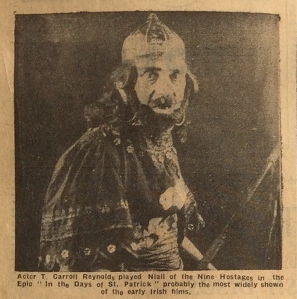
T. Carroll Reynolds as Niall of Nine Hostages in Aimsir Padraig. Standard 17 Mar 1961: 1.
To give a brief summary of the film: it begins with Patrick’s birth surrounded by angels, a scene that forms a sort of angelic prologue before scenes of Patrick’s early life with his family near the sea in Gaul, including his baptism and his first miracle in which he kindles ice to make a fire. He is then kidnapped by Irish raider Niall of the Nine Hostages and shipped to Ireland, is sold at a slave market and becomes a swineherd, learning Irish in the process. A vision of the angel Victor tells him to leave Ireland. He becomes a priest in Gaul, has a vision that Ireland needs him, is ordained bishop in Rome and lands with followers in Ireland. He makes his first conversions and lights a Paschal fire on the hill of Slane, unwittingly breaking a proclamation of High King Laoghaire of Tara. Patrick successfully confronts the force Laoghaire sends to arrest him, drinks poisoned wine at Tara without harm and converts Laoghaire. The film finishes with two sequences, one showing other important elements of the Patrick legend and the other an epilogue of newsreel featuring sites associated with Patrick, the 1919 Pilgrimage to Croagh Patrick and Cardinal Logue at St Patrick’s Cathedral in Armagh.

GFS cameraman J. Gordon Lewis shot Aimsir Padraig; Irish Limelight Jan. 1918: 10.
Irish cinemagoers would been familiar with the ancient world of Rome depicted on screen, and Ireland’s distant history had been portrayed on Irish stages, including in Ira Allen’s 1917 drama Tara’s Halls, or, St. Patrick and the Pagans. Indeed, Allen and his play were key contributors to Aimsir Padraig, with Allen taking the part of the adult Patrick. As the play text does not survive, it is difficult to establish how closely the film follows it. In one of the earliest extant references to the film, Bioscope then Irish correspondent Fingal reported in April 1919 that Allen was taking the title role and that “the scenario is by Mr. McGuinness, manager of the G.F.S., Mr. Norman Whitten is the producer, and the camera man is Mr. J. Gordon Lewis” (“Irish Notes” 10 Apr). Some early scenes had already been shot, and “these earlier episodes were taken amid snow-covered country, which forms an effective background for the dark habits of St. Patrick and his monks.”
JAP would take over the “Irish Notes” at the Bioscope at the end of May 1919 and provide further reports from the Aimsir Padraig set as production continued. Whitten began using the term Eire productions for his new fiction film venture, and he seems to have developed studios at his offices in Great Brunswick (now Pearse) Street, which “will enable interiors to be filmed all the year round” (“Irish Notes” Apr 17). He later changed to Killester productions, as he was building “a fine studio, in admirably picturesque enclosed grounds” in that suburb of north Dublin (“Irish Notes” Sep. 25).

Images from the slave galley and possibly Patrick confronting Laoghaire’s troops; Bioscope 30 Oct. 1919: 52.
The lack of and necessity for the controlled environment of a studio was underlined by JAP’s stories from the set and his experiences as an extra. The film’s three most spectacular scenes were of the galley that brought Patrick to Ireland, the market where he was sold as a slave and the lighting of the Paschal fire. “During a scene which represented the landing of St. Patrick in Ireland,” he revealed,
the sea showed the rough edge of its temper unexpectedly, and St. Patrick and the company had a pretty severe buffeting. To add to their troubles, a modern fishing smack ran down the ancient galley, which was conveying the saint (then a youthful slave) and the other slaves to land, and various of the players were spilt into the waves. (Ibid.)

Patrick’s sister Lupita (Alice Keating) is sold at an Irish slave market.
Among those injured was Alice Keating, who played Patrick’s sister Lupita. “The chain which fettered her wrists caught in one of the oars or ‘sweeps’ of the galley as she was thrown into the water, and the oar struck her on the head, inflicting a nasty scalp wound. Pluckily, however, she insisted on going on with her part.”
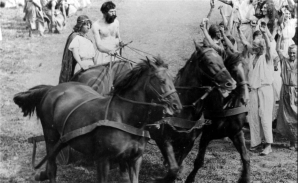
One of the king’s chariots arrives at the slave market.
Not that the studios at Killester guaranteed perfect health and safety, as an anecdote about the use of chariots at the slave auction there suggests. “King Melchio […] having read, presumably, the auction advertisements, turns up in state to see if the goods are up to the shout,” JAP related.
He is accompanied by the Queen and the Princess, and they arrive in three separate and distinct chariots.
They rehearsed this incident so many times that the three horses drawing the King’s chariot got tired of it, and created a ‘divarshun’ by bolting. Mr. Mackie, who was disguised as charioteer, stuck on, and a moment later was flung into a bunch of bushes as the chariot upset. (“Irish Notes” 25 Sep.)
An article in the Irish Times suggests that this incident occurred on 11 September, when “about 200 men and young women posed for the cinematograph, and subsequently there were chariot races on the strand at Portmarnock” (“General Film Supply”).

JAP witnessed the production as participant as well as observer when he took the role of extra – or “super” – in the scene of the lighting of the Paschal fire on the hill of Slane. He published a page-and-a-half account in the Bioscope on 30 October 1919, but a photo that appeared in the Evening Telegraph on 11 October indicates that the scene was shot three weeks earlier on 10 October. “The first job I got,” he reveals after having been costumed and made up, “when we climbed to the top of [Slane] hill was gathering wood. The camera took up its stand in a strikingly picturesque corner of the fringe of a wood, and the programme was that some of the other supers and I should emerge from the trees, bearing bundles of brushwood and logs.”
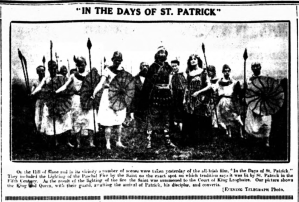
A production still from Aimsir Padraig that appeared in the Evening Telegraph on 10 Oct. 1919. The caption reads: “On the Hill of Slane and in its vicinity a number of scenes were taken yesterday of the all-Irish film, ‘In the Days of St. Patrick.’ They included the Lighting of the Paschal Fire by the Saint on the exact spot on which the tradition says it was lit by St. Patrick in the Fifth Century. As the result of the lighting of the fire the Saint was summoned to the Court of King Laoghaire. Our picture shows the King and Queen, with their guard, awaiting the arrival of Patrick, his disciples, and converts.
However, he suffered an unfortunate costume malfunction, when he discovered the sandals that he had been given were too small. “I was wrestling with them when the megaphone began to shout insistently,” he admits. “There was nothing for it but to revert to the customs of my far-distant ancestors, so I made my appearance bare-footed. It was some consolation to find that my neighbouring convert – a prominent Dublin exhibitor – was in a similar plight.” Despite the humorous tone of the article, the presence of so many other members of the industry willing to make up the crowd scenes suggests that it was widely regarded as an important undertaking. “We were a light-hearted band of moderns as we climbed that Hill of Slane,” as JAP puts it.
We realised that we were engaged on a task that was something more than the making of an ordinary motion picture. We were producing a film that would be have special appeal for millions of people scattered over the earth. Our task was to visualise for them one of their most intimate traditions; to bring before their eyes a personality vastly more real to them than any other figure in history. We – all of us, from the producer to the most insignificant super – were determined to do it to the best of our ability.

Ad for rights to distribute Aimsir Padraig abroad; Bioscope 13 Nov. 1919: 111.
An unnamed writer at the Irish Limelight witnessed but seems not to have participated in the same scene, observing that it “created a remarkable impression, which is bound to gain rather than lose in force when it is reproduced on the screens of the world.” For this writer, the film represented the start of a new kind of entertaining and informative filmmaking: “In this sphere a wide field of activities opens itself for Irish producers, who can, at the same time, satisfy commercial needs, and teach the history of an ancient civilisation to the people of Ireland as well as the people of the world” (“In the Days of St. Patrick”).

St Patrick banishes Ireland’s snakes: a scene whose realism one critic thought would cause hysteria among unsuspecting ladies. Standard 17 Mar. 1961: 1.
Two other notable features of the production – the treatment of miracles or other fantastical happenings and its use of Irish – were mentioned in JAP’s last 1919 Bioscope item on Aimsir Padraig. The shooting seems to have gone on for most of 1919, only finishing as JAP’s 13 November column appeared. Some of the most famous scenes were saved until last. “The other day St. Patrick, in accordance with tradition, drove the snakes out of Ireland,” JAP recorded. “Howth Head, some nine miles from Dublin, was the scene, and the exit of the reptiles was so realistic that some ladies walking along the cliff path and coming unexpectedly on the sight, might be pardoned for hysterics.” The specifics of Howth as a real Irish place is apparent here as it had been with Slane, Tara and Killester. Not that these places were all connected with the historical Patrick, but they were the actual places in which the film was shot and in which some unsuspecting contemporary ladies might be disturbed by the appearance of seemingly real snakes. But this reality and geographical specificity was also linked to metaphysical power and to the ability of Irish filmmakers to reproduce such power on the screen. This was guaranteed in part by mostly unnamed historians and clerics. Whitten “has had expert advice at every stage of the production, and a well-known ecclesiastic who is an authority on the Saint’s life, personally supervised some of the more important scenes.”
Whitten was very clearly making a political film, but one very different from his banned Sinn Fein Review. Aimsir Padraig was political in appealing to an Irish separatism based not on the politics of Sinn Féin and the IRA but on Catholicism and Gaelic culture expressed in the speaking of Irish or aspiring to. “The titles and sub-titles will be in Gaelic and English,” JAP explained in the same Bioscope item, “and here again the expert is employed, the Irish translations having been supplied by one of the best Gaelic scholars in Dublin.” The film’s titles were specially designed by William J. Walsh, and an opening title listed the Irish translator as Fiachra Eilgeach. The increasingly politicized Gaelic League, the body promoting Irish learning, had been declared illegal in September 1919. The learning of Irish is depicted in the film in a scene that is Patrick’s only really positive experience as a slave in Ireland. Working as a swineherd, Patrick “learns the Irish Language at the foot of Mount Slemish from his companions” (intertitle). Patrick is shown attempting to pronounce the Irish words they mouth for him, and they laugh heartily. The film’s bilingualism is its most obvious uniqueness because it is present from the moment one sees or hears its title. To some extent this bilingualism is a feature of many Irish film, such as Rosaleen Dhu or Willy Reilly and His Colleen Bawn with their conventional Anglicizations of Irish phrases. Aimsir Padraig moves beyond these conventions well known from the Irish play, albeit that it brings many others with it, as we have seen.

Ad for trade show of Aimsir Padraig/In the Days of St Patrick, Irish Independent 27 Jan. 1920: 4.
Given the interest and involvement in the production, it is hardly surprising that the trade show at the Grafton Street Picture House on 30 January 1920 received a high degree of attention not only in the trade press but in the Irish dailies more generally. JAP covered it for the Bioscope on 5 February and was doubtless responsible for the unsigned article on the trade show in the Evening Telegraph on 2 February. “It got a remarkably good reception from a crowded audience,” he revealed in the Bioscope, “which included practically every representative of the Trade in the Irish capital, a very large number of clergymen, and some of the principal members of the Film Company of Ireland.” “The life of Ireland’s patron saint has been filmed before now,” he noted in the Telegraph, referring to the 1912 Life of the St. Patrick: From the Cradle to the Grave by J. Theobald Walsh for the New York-based Photo-Historic company. However, “anything previously attempted fades into insignificance compared with this picture. ‘In the Days of St. Patrick’ is remarkable, not alone for its historical accuracy – in the matter of setting and costumes as much as in its strict adherence to the known facts of the Saint’s life – but for its wonderful photography” (“Irish Film Production”). Nevertheless, he was not wholly complimentary, commenting in the Bioscope that it “is not wholly free from the blemishes incidental to a first production – some scenes would bear cutting – notably that which shows St. Patrick being made a bishop,” a scene that certainly feels too long in the IFI Irish Film Archive’s surviving print.

Programme for Galway’s Victoria Cinema featuring Aimsir Padraig; Connacht Tribune 24 Apr. 1920: 3.
As a result of this publicity, the film had momentum behind it when it opened for the public on 15 March 1920 at Dublin’s Phibsboro Picture House, Rathmines Town Hall and Kingstown Picture House, as well as at Limerick’s Theatre Royal and Derry’s St Columb’s Hall. Other well-advertised runs followed at Sligo’s Town Hall (24-26 March), Cork’s Washington Cinema (5-10 April), the Picturedromes in Clonmel and Tipperary (5-7 April), Waterford’s Broad Street Cinema (15-17 April), Belfast’s St Mary’s Hall (19-24 April), Galway’s Victoria Cinema (26-27 April), Kilkenny’s Empire Theatre (3-5 May), Castlebar’s Ellison Cinema (7-10 May) and Carrick-on-Suir’s Park View Cinema (30 June-1 July).
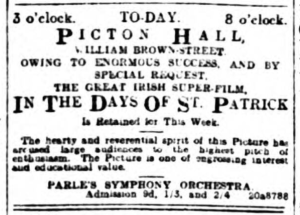
Liverpool Echo 29 Jul. 1920: 1.
While Irish screenings became more sparse after this, British dates began to appear, with Liverpool’s Picton Hall advertising it for two weeks beginning 1 August, then retaining it for a third when a Liverpool Echo ad claiming that “the hearty and reverential spirit of this Picture has aroused large audiences to highest pitch of enthusiasm. The Picture is one of engrossing interest and educational value.” It also had a four-day run at Motherwell’s Town Hall beginning on 15 November 1920. But Whitten’s ambitions for the film were larger still. He advertised the American and colonial rights for sale, and at the end of June, JAP reported that he had taken the film to the United States some months earlier and was still there. “He has visited Los Angeles and all the big film-producing centres,” JAP revealed. “In a recent topical film from the United States of America, his friends in this country were amused to see N.W., ‘as large as life,’ figuring as a spectator just behind De Valera” (“Irish Notes,” 24 Jun.).

Aimsir Padraig at Ellison’s, Castlebar; Connaught Telegraph 1 May 1920: 2.
If he was away so long, it is not clear how much of the film’s Irish reception Whitten experienced first-hand. No doubt he or someone at GFS sent out press releases with materials on the film to the cinemas and newspapers in the towns in which the film screened. In several towns, the newspapers published this material at some length and with regional variations. Fewer places reviewed the film in a way that gives an indication of local reaction beyond the press. The first of these came from the Evening Herald, which published a notice of the opening day at the Phibsboro Picture House that is worth quoting at length for the details that are included in other articles on the film. “The Killester super-film, ‘In the Days of St. Patrick,’ was witnessed at each presentation yesterday by full and appreciative audiences,” it begins.
The film is all that has been claimed for it, and is one of transcendent beauty. Many of the actual spots in our isle hallowed by the footsteps of our National Apostle are included in the production, and each and all the participants in the magnificent presentation show a carefulness regarding histrionic detail that invests each scene unfolded with charm. The epilogue to this great picture is most interesting – showing St. Patrick’s grave at Downpatrick, some relics of the Saint, last year’s pilgrimage to Croagh Patrick, the Armagh Cathedral, and our Apostle’s successor, his Eminence Cardinal Logue. It may be mentioned that the descriptive particulars of the scenario are in both Gaelic and Bearla [English]. The orchestral selections were in harmony with the picture. Included in the programme were the Houdini serial and a side-splitting Chaplin comedy, “Charlie’s Night Out.” (“The Phibsboro’.”)
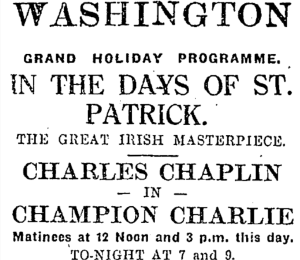
Cork Examiner 5 Apr. 1920: 4.
Many of the details are familiar from other previews and reviews: the size and appreciation of the audience, the beauty of the images, the use of locations associated with Patrick, the interest of the newsreel and the bilingualism. Many notices more strongly emphasized the “all Irishness” of the production, notwithstanding Whitten’s own English origins. The Cork Examiner’s review of the shows at Cork’s Washington Cinema claimed that the film was “a truly All-Irish film, the artistes, photography, scenery and titles all being Irish. It is claimed to be the only All-Irish masterpiece yet produced” (“Washington Cinema”). Both the Washington and the Phibsboro chose to programme Aimsir Padraig with a Chaplin comedy, but fuller details in such areas as the actual names of the appropriate music provided in Phibsboro and elsewhere would be welcome. In Castlebar, Ellison’s promised “a grand concert each night, the services of Mr. Michael Maguire, Dublin, a famous baritone, having been engaged” (“Wonderful Picture”).

St Patrick’s Day programme at St Columb’s Hall, Derry; Derry Journal 15 Mar. 1920: 4
Only at Derry’s St Columb’s Hall on St Patrick’s day did an Irish programme support Aimsir Padraig to provide what the review called an “Excellent Irish Entertainment.” In this case, a concert of Irish songs, many of them in Irish and by singers who specialized in Irish-language material, preceded the screening of Aimsir Padraig. Vocalists Maud Clancy and Jack Collins were advertised for the full week, but on St Patrick’s night, they were joined by Maighread Ní L’Annagain and Seamus de Clanndíolun. “The possessor of a sweet and tuneful voice,” Ní L’Annagain “sang several numbers in delightful style. She gave most successful renderings of ‘Una Bhan,’ ‘The Peasant’s Bride,’ ‘Jackets Green,’ ‘Cleim an Fhiadha,’ ‘The Minstrel Boy,’ ‘An Rois Geal Dubh,’ and her efforts met with unstinted and well deserved admiration.” Dancing of jigs and hornpipes followed the singing before the film screening was accompanied by unspecified “Irish selections by the orchestra, directed by Mr. J.S. O’Brien.”
Albeit that it was rare, the release of two new Irish films created the possibility that Irish picture houses in 1920 could provide what contemporary observers thought was an excellent Irish cinematic entertainment.
References
“Back to the Fifth Century: Our Irish Representative Makes His Debut as a Film Actor: A Pressman in Ancient Ireland.” Bioscope 30 Oct. 1919: 52.
“Celtic Film Company’s ‘Rosaleen Dhu.”” Irish Limelight Dec. 1920: 19.
Denvir, John. Rolsalee Dhu; or The Twelve Pins of Bin-a-Bola. Denvir, 1874.
“Excellent Irish Entertainment in St. Columb’s Hall.” Derry Journal 19 Mar. 1920: 8.
“Festival: Engagements in the City and throughout the Country.” Freeman’s Journal 17 Mar. 1920: 5.
“General Film Supply: Preparing ‘In the Days of St. Patrick.’” Irish Times 12 Sep. 1919: 6.
Ging, Debbie. Men and Masculinity in Irish Cinema. Palgrave Macmillan, 2013.
Hughes, Tom. How Belfast Saw the Light: A Cinematic History. Hughes, 2014.
“In the Days of St. Patrick.” Irish Limelight Nov. 1920: 10.
“Irish Film Production: Wonderful Picture of the Life of St. Patrick: Splendid Photography.” Evening Telegraph 2 Feb. 1920: 2.
“Irish Notes.” Bioscope 10 Apr. 1919: 119; 17 Apr. 1919: 104-05; 25 Sep. 1919: 105; 30 Oct. 1919: 53, 54; 5 Feb. 1920: 113; 13 May 1920: 112; 24 Jun. 1920: 105.
“The Life of St. Patrick.” Sligo Champion 20 Mar. 1920: 4.
“Notes and News.” Irish Limelight Dec. 1919: 3.
O’Fearail, Padraig. “When Films Were Made in Bray.” Irish Times 16 Aug. 1977: 8.
“The Phibsboro’.” Evening Herald 16 Mar. 1920: 3.
Rockett, Kevin. The Irish Filmography. Dublin: Red Mountain, 1996. Expanded online as the basis of Irish Film and TV Research Online. Trinity College, Dublin. https://www.tcd.ie/irishfilm/.
“‘Rosaleen Dhu.’” Sligo Champion 13 Mar. 1920: 4.
“Rosaleen Dhu.” Nationalist and Leinster Times 8 Apr. 1922: 2.
“St. Patrick’s Day: Celebrations in Cork: Imposing Procession: Clergy and Corporation.” Cork Examiner 18 Mar. 1920: 5, 8.
“Washington Cinema.” Cork Examiner 6 Apr. 1920: 4.
“A Wonderful Picture.” Connaught Telegraph 8 May 1920: 2.
